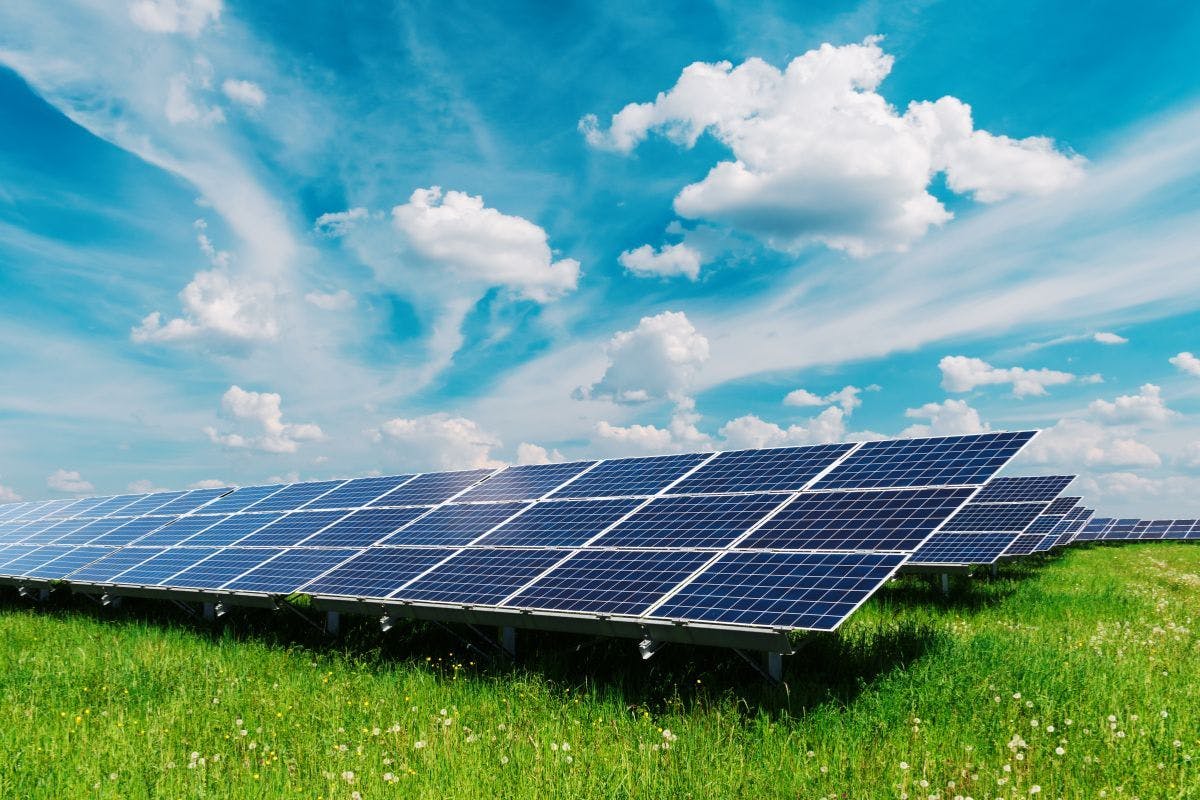Climate Change Is an Energy Problem. Here's How Solar Can Help
Last edited

Author
Brian Church
Writer

Editor
Andrew Blok
Electrification and Solar Writer and Editor

Understanding climate change begins with one key truth: It is primarily caused by human activity.
Which human activity, specifically?
Well, for one, burning fossil fuels like coal, oil, and gas.
Although several other human-driven factors contribute to climate change (like deforestation and land use), fossil fuel extraction, refinement, and combustion are responsible for the majority of greenhouse gas emissions currently trapped in the Earth’s atmosphere.
In 2024, the United Nations (UN) estimates that fossil fuel consumption is responsible for 75% of global greenhouse gases, including nearly 90% of carbon dioxide (CO2) emissions. It’s clear that alternatives to fossil fuels, like solar energy, are more important than ever.
In this article, we explore how global warming is caused by and threatens access to traditional fossil fuel resources and showcase the sustainability, financial, and climate benefits of solar energy.
See how much you can save by going solar with Palmetto
Energy Consumption and Climate Change
Since the Industrial Revolution, fossil fuel consumption rates have been increasing worldwide alongside a rising demand for energy.
Although net zero goals and energy efficiency improvements are being implemented to combat global warming, the US Energy Information Administration (EIA) projects that the emissions from increasing global energy demand are currently outpacing gains from climate action.
Fossil fuels exacerbate climate change in a way that is destructive and in desperate need of reconsideration.
For the sake of time, let’s break it down into three key phases.
- Greenhouse gas emissions come from human activities
- Greenhouse gases have an effect on the planet
- Those changes negatively impact humans, energy, and the environment
Human activities causing greenhouse gas emissions
Burning fossil fuels to generate electricity also generates a lot of pollution, including greenhouse gases like carbon dioxide, methane (CH4), and nitrous oxide (N2O).
Emissions from energy production, agriculture, and other human activities totaled 6,343 million metric tons of CO2 equivalent in 2022, according to the Environmental Protection Agency (EPA).
In the same year, the EPA found that generating electricity produced 25% of GHG emissions, second only to transportation, which accounted for 28% of the US total.
Greenhouse gases and climate change
Although everyone you meet is not going to be a climate scientist, understanding climate change has reached a sort of tipping point in the US, with the majority of the population at least concerned about its effects.
In 2020, approximately two-thirds of Americans surveyed by the Pew Research Center felt as if the US was not doing enough to combat climate change as a whole.
In 2024, one-third of relocating Americans surveyed by Forbes cited climate change as a motivator behind their move, with new homeowners hoping to avoid future instances of hurricanes, tornadoes, and other environmental disasters.
The US has seen a rise in disasters that cost $1 billion, as climate change makes hurricanes, wildfires, and heat waves get more severe, according to NOAA. In 2023, there were 28 such events, the most ever recorded.

Credit: NOAA
Impact on the environment, energy, and humanity
If you’ve made it this far into the article, then we probably do not have to tell you that climate change matters. Global warming threatens humanity’s way of life, including our ongoing access to food, clean water, electricity, and other vital resources.
While the impact of global warming can be felt in many different forms all over the planet, two climate change effects stand out among the rest as major threats to energy sustainability: global temperature rising and higher frequencies of extreme weather events.
During extreme weather, access to grid-supplied energy can be compromised if heavy winds, flooding, fire, hail, or something else were to cause power line damage or a local electrical outage.
In the same sense, global temperature rises can lead directly to higher energy demand from air conditioning systems, which already account for about one-fifth of home electricity consumption in the US.
With increased energy demand throughout the warmer seasons, greater strains on the power grid can lead to supply imbalances and price surges in areas with dynamic, time-of-use electricity rates.
Climate Change and Home Energy Use
If you are sitting at home wondering what specific steps you can take towards climate action and greenhouse gas emission reduction, there are a few major upgrades you can make without seriously changing your lifestyle or location.
For one, driving an EV can dramatically reduce your annual greenhouse gas emissions if you currently drive a personal vehicle with a fuel-combustion engine.
That said, if you are charging the battery for your electric car, truck, or SUV at home daily, it may still be running on fossil fuels from grid-supplied power. In 2023, fossil fuels were responsible for about 60% of total US electricity generation.
To lower your carbon footprint, reducing grid energy consumption by means of efficiency improvements and alternative energy can be among the most impactful things you can do to mitigate the effects of climate change at home.
See how much you can save by going solar with Palmetto
Renewable Energy and Mitigating Climate Effects
To eliminate future greenhouse gas emissions from production in the first place, renewable energy is stepping in to replace fossil fuels and save the planet one installation at a time.
Although the definitions of sustainable energy, green power, and clean electricity can all be a little loose at times, the most prominent renewable energy sources today include solar, geothermal, hydropower, wind, and wave.
Whereas some greenhouse gases are generated during the production and installation of renewable power equipment, there are no carbon emissions associated with the electricity production itself, which makes these technologies significantly greener than fossil fuels.
Even further, renewable power systems rely on sustainable (rather than limited) supplies of energy such as sunlight and the wind.
In the National Renewable Energy Laboratory (NREL) chart below, you can see how the lifetime GHG emissions of renewable resources stack up against those associated with fossil fuels and other non-renewables.

Spotlight on Solar Energy
Of course, here at Palmetto, our favorite renewable energy resource is solar, which just so happens to be the fastest-growing and cheapest new form of electricity in the world.
From massive solar farms to single-home rooftop installations, solar panels can be used in a wide variety of applications and require very little ongoing maintenance. Once the equipment is set up, voila, all you need is a bit of direct sunlight and a lot of wiring, and there you have it: emission-free power generated onsite.
No, it's not magic or rocket science; it’s just solar power, a technology with serious implications for the future of energy access, energy security, and affordable living.
Financial benefits of going solar
As an alternative to traditional grid-supplied energy, American home, business, and property owners can install photovoltaic (PV) solar panels to reduce ongoing electricity costs. While the exact financial benefits will vary for every project, most homeowners with properties suitable for solar power generation can save on long-term electricity expenses, either immediately or over time, depending on how they pay for that solar.
Take, for example, the 2024 Solar for All program from the US government. Intended to help power 900,000 low-income households with solar energy, the program will reduce an estimated $350 million annually in residential electricity expenses across the US.
If you’d like to see how much you can save on energy bills with renewable power, try the Palmetto solar calculator.
Climate benefits of going solar
Solar energy is playing an increasingly important role in combating global warming.
While widespread solar adoption has obvious climate benefits (such as improved air quality and conservation of natural resources), it’s pretty great to know that every person who chooses to install solar panels can effectively reduce potential greenhouse gas emissions and air pollutants in their own backyard.
Let’s say you live in Georgia, where roughly 60% of statewide electricity production is generated from natural gas or other fossil fuel resources. If your home consumes 13,000 kWh (kilowatt-hours) of electricity each year, this would translate into about 7,800 kWh of energy consumption generated from fossil fuels.

Avoiding this 7,800 kWh of fossil-generated electricity with solar, the EPA estimates, could offset 5.4 metric tons of carbon dioxide (CO2) equivalent. According to the EPA’s equivalency calculator, this is roughly the same amount of pollution that would be otherwise generated while burning 6,000 pounds of coal or a dozen barrels of oil.
Solar and energy security
In addition to lowering your electricity bill and personal carbon emissions, solar power can provide resiliency in the face of increasing power outages.
Most importantly, panels installed with integrated solar battery storage can temporarily pivot off the grid and run independently during local electrical outages or rate hikes.
This is happening all over the country with hospitals, transportation hubs, and other essential services adopting renewable microgrids and virtual power plants.
Palmetto Home Solar Solutions
Palmetto offers home solar energy solutions in many areas of the United States. We empower homeowners to reduce personal greenhouse gas emissions and energy expenses with solar power anywhere the sun shines.
If you’d like to go green and save some money while doing so, Palmetto can help protect and maximize your investment in the planet and your home’s renewable energy supply. We offer home solutions and solar energy products with custom designs and contracts for every homeowner.
Buying solar with Palmetto
When you purchase a solar panel system with Palmetto, you can take control of your clean energy future and unlock your maximum energy savings potential over the multi-decade lifespan of your system.
On top of this, a purchased solar energy system can increase your home value and may qualify for several government and utility financial incentives to promote affordable renewable technologies.
If purchasing a solar panel system turns out to be the best choice for your home and budget, Palmetto offers several financing options in lieu of an outright cash purchase. With loan terms from five to twenty-five years and variable upfront payment options (including $0 down), a Palmetto solar expert can help you find the right contract to optimize your home’s energy cash flows and maximize your long-term electricity bill savings.
Learn more about buying or financing solar with Palmetto.
The Palmetto LightReach Energy Program
The Palmetto LightReach Energy Program provides a third-party ownership model for homeowners to generate solar-powered savings with no money down and without a loan or financing.
With no upfront costs and a system designed to deliver savings in its first year, the LightReach Energy Program is the easiest path to greenhouse gas emission reductions on your property.
Learn more about the Palmetto LightReach Energy Plan.
Palmetto Protect plans and after-sales service
Included for all LightReach customers, Palmetto Protect is the secret sauce that keeps solar sustainable for homeowners across the US. While solar panels are a relatively low-maintenance technology, Palmetto Protect ensures every single aspect of your installation will be working at its full potential over its lifetime.
Here are a few of its features that ensure your solar system stays in tip-top shape:
- Proactive system monitoring and 24/7 customer service
- Energy performance guarantees at 90% of estimated production
- Parts, labor, troubleshooting, and repair costs are all covered under your warranty
Learn more about Palmetto Protect plans.
Bottom Line
At the end of the day, understanding climate change is the first step in addressing it, no matter who you are, where you live, or the current size of your carbon footprint.
If you just so happen to be a homeowner in the United States, going solar can be extremely impactful, both in reducing greenhouse gas emissions and lowering your ongoing electricity expenses.
So whether you are in it for the planet or your wallet (or both, let’s be honest), you can contact a Palmetto solar advisor to explore your options today.


